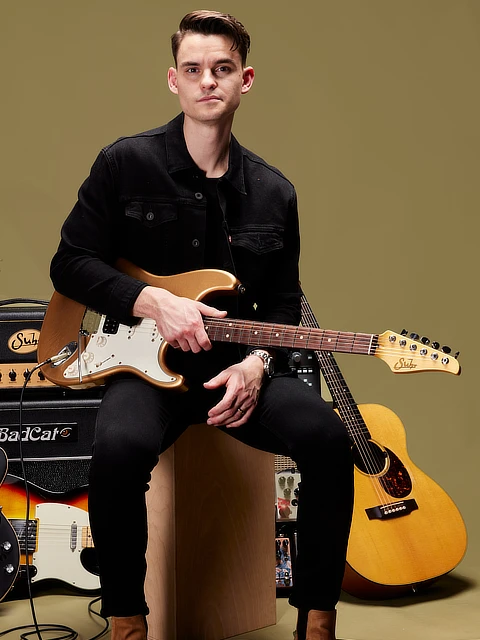
For the past 75 years, the electric guitar has been a staple of popular music, yet it still manages to surprise us with its versatility. It can serve as a lead instrument, a rhythm backbone, a solo voice, a percussive element, a synthetic layer, or a textural tool—the possibilities are endless.
Rather than crafting a narrative, this post is about expanding your perspective. Whether you’ve been playing for years or just a few months, I believe you’ll find valuable insight here—hopefully, even some inspiration. While I could write endlessly about the many niche aspects of the electric guitar, I’d rather take a broader approach, sharing what has kept me motivated and excited to play for the past 18 years. These are the lessons I pass on to my students and the foundation of my curriculum. Simply put, this is the best advice I can offer you!
BROADEN YOUR HORIZONS
My earliest days of playing guitar were mostly spent listening to—you guessed it—guitar players. While some of them had great ideas that pushed the boundaries of what was typical at the time (Jimi Hendrix, Tom Morello, Steve Vai, and Eddie Van Halen, to name a few) it wasn’t until I started listening to OTHER instruments that I really began to push my own understanding of what I COULD do. Listen to other genres that DON’T have guitar. Listen to movie scores. Listen to synthesizers—how can you emulate those styles? How can I make the guitar take up as much sonic space as possible? Can I adapt this piano part to the guitar? This is where I see breakthroughs happen most often in my own playing—your mileage may vary.GET OUT OF YOUR COMFORT ZONE
Sometimes, the best way to dive in is to take the leap with both feet. Throughout my journey as a musician, there have been pivotal moments when I took bold risks—especially on electric guitar —and those risks paid off in ways I never imagined.
Learn a new genre. Take a gig or opportunity you’re “not ready” for. Ask one of your musician friends who don’t play guitar what they think you could do better as a contributing member of the band. Ask for hard, constructive feedback from a worship leader, teacher, or other people who have heard you play. Find a way to record yourself (it’s easier than ever) and evaluate how well you can play along with a metronome. This will not only help you assess areas for growth but may also surprise you with how far you’ve come!
DO THE HOMEWORKLearn what gear your favorite players use. What kind of guitar do they play? What amp powers their sound? What’s on their pedalboard, and is there anything unique about their setup? Did they use different equipment in the studio versus live performances? If so, is there a more affordable way to replicate those tones? Beyond their gear, who inspires them? Do they use open or alternate tunings? Watch live performances—do they approach phrasing or chord voicings in a distinctive way? There’s always a wealth of knowledge to gain from those who inspire us, and thanks to the internet, accessing it has never been easier.
DO THE HARD WORKEveryone wants to be a great musician, but very few are willing to put in the work. Getting new gear is exciting, but spending a couple of hours a day practicing? Not always. Take the time to REALLY learn that song you love but haven’t quite figured out. Watch videos of your favorite players and try to dial in the sounds that inspire you most. Grab a chord book, learn some new shapes you’ve never seen before, and use a few to write a progression or even a song. Find a solo that feels out of reach, then chip away at it until you nail it. Before long, you’ll realize that almost ANYTHING is possible to learn and play—if you’re willing to put in the effort.
HAVE FUN!At the end of the day, it’s called playing guitar, not working guitar. Music is one of the few things that transcends time—it connects people across generations and never fades. And few instruments offer the sonic possibilities of the electric guitar. If you find yourself in a rut, forget the rules and just play what feels good. Play things that sound bad. Don’t take yourself too seriously! Learn a simple song you love. Experiment. Break the rules.
Who knows—you might even make a career out of it. But more importantly, you’ll rediscover the joy that made you pick up the guitar in the first place.
Join us at Animate 2025 to deepen your understanding of worship and sharpen your own artistic skills! Registration is open through May 15! Choose from a variety of tracks and participate in hands-on classes, including guitar sessions led by the author of this post, Riggs Taylor.

Riggs Taylor is the primary guitar instructor at Samford University. He has spent thousands of hours performing live and recording in the studio with many artists, as well as serving the church as a worship leader and music director. He also works with a lot of companies in the music industry, such as BadCat Amplifiers, Keeley Electronics, Origin Effects, and many more.
Explore more posts about music and worship in the church:
Global Worship: Embracing Diversity in Worship Leading
